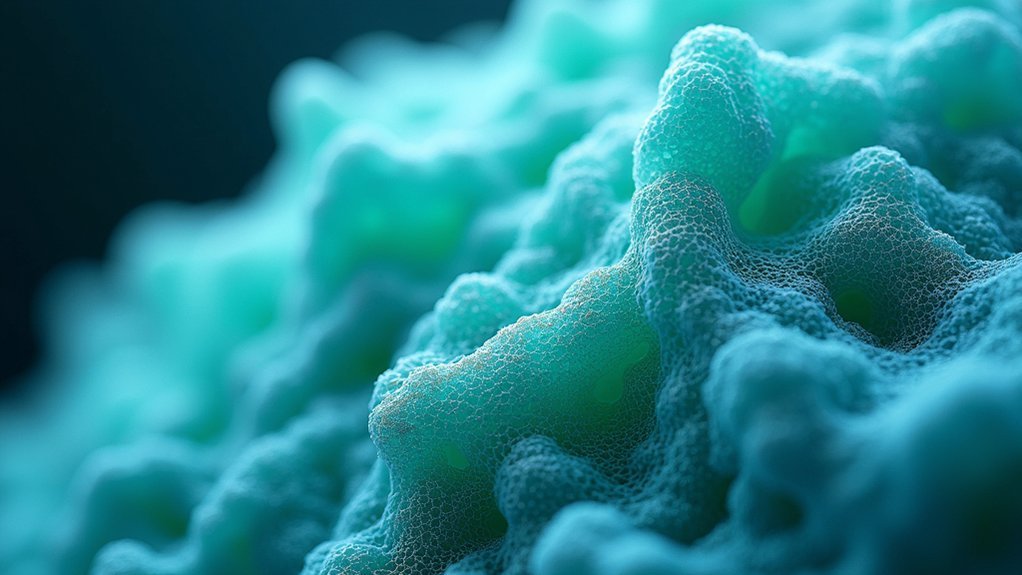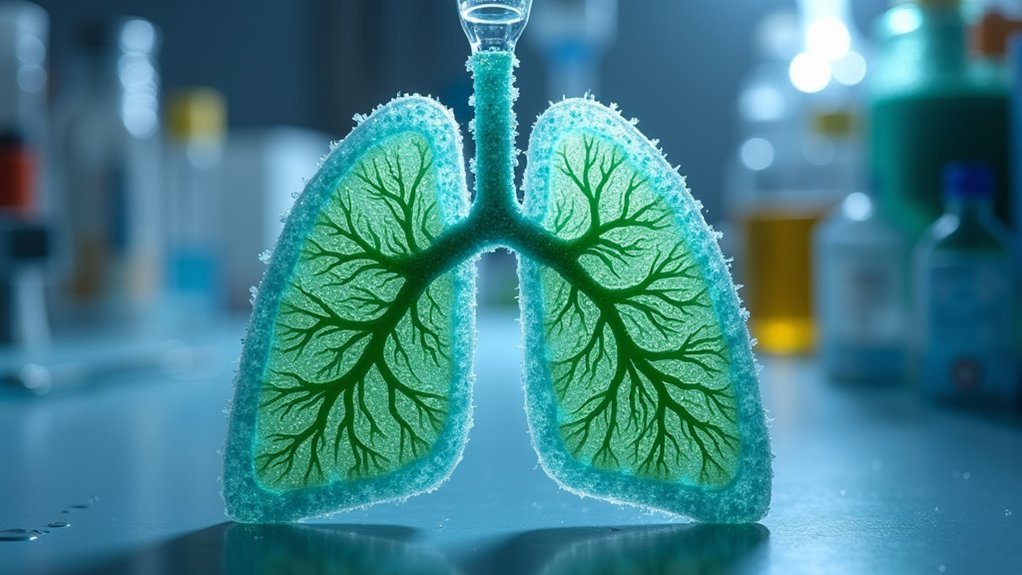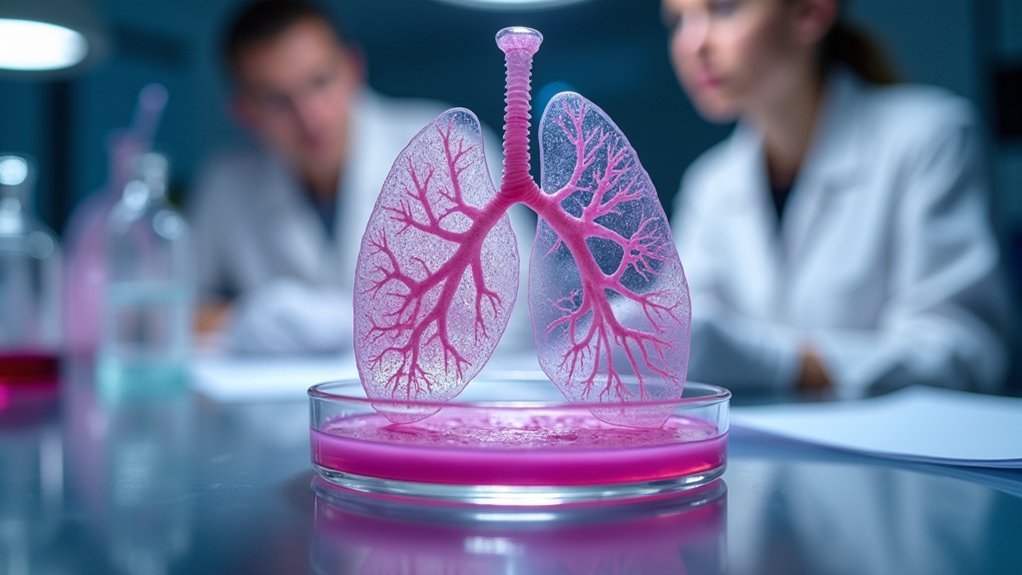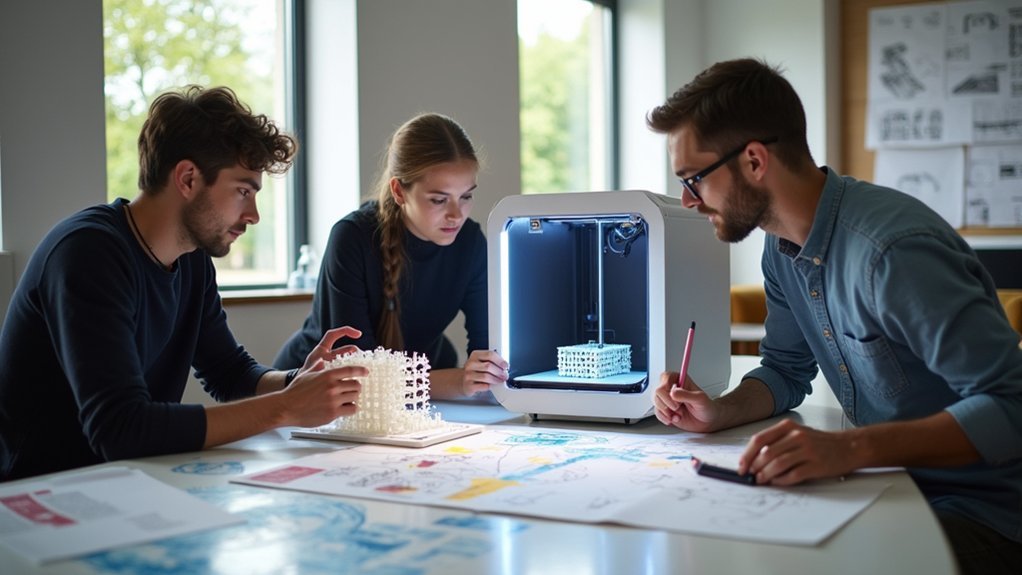You can successfully bioprint lung tissue because advanced bioinks like methacrylated mucin precisely replicate the lung’s complex architecture of over 60 cell types while matching its 2.0 kPa stiffness. Modern printing technologies enable you to create interconnected porous scaffolds that mimic natural alveolar-capillary barriers and branching airways. These bioprinted models surpass traditional cell cultures for disease research and drug testing, offering personalized therapeutic solutions that could eliminate organ waiting lists and transform respiratory medicine.
Understanding Lung Tissue Complexity and Cellular Architecture

The lung’s intricate architecture represents one of nature’s most sophisticated biological systems, housing over 60 distinct cell types that work in seamless coordination to sustain life.
You’ll find epithelial cells, fibroblasts, and immune cells performing specialized functions within complex structures that maintain respiratory health. When you’re considering bioprinting applications, understanding this cellular diversity becomes essential.
The extracellular matrix (ECM) comprises nearly 50% of nonalveolar tissue, facilitating important cell-cell interactions and providing structural integrity. You can’t replicate lung function without appreciating how alveoli occupy 65% of surface area, creating ideal gas exchange through ultra-thin barriers.
The lung’s extracellular matrix forms half of nonalveolar tissue while alveoli dominate surface area for optimal gas exchange through microscopic barriers.
Successful tissue bioprinting requires mimicking these precise cellular arrangements and ECM compositions that enable proper lung mechanics and biological responses.
Advanced Bioinking Materials for Respiratory Applications
When developing effective respiratory tissue constructs, you’ll need bioinking materials that can replicate the unique biochemical and mechanical properties of native lung tissue. Advanced bioink formulations like methacrylated mucin (MuMA) and hyaluronic acid enhance viscosity while promoting cell adhesion essential for successful bioprinting technology.
These materials create an extracellular matrix (ECM) that supports cell viability through interconnected pores, allowing nutrients and oxygen to reach embedded cells effectively.
- Crosslinking agents activated by blue light transform liquid bioinks into stable, porous scaffolds resembling lung architecture
- Mucin’s antibacterial properties protect developing lung tissue models from contamination during culture
- Biodegradable formulations gradually dissolve as natural tissue replaces the printed structure
- Accurate disease processes modeling enables researchers to test treatments for chronic respiratory conditions
Precision 3D Printing Technologies for Lung Models

Building on these advanced bioink formulations, precision 3D printing technologies transform how you create complex lung tissue models by offering unprecedented control over cellular placement and structural geometry.
You’ll find inkjet-based bioprinting delivers high-speed, high-resolution capabilities essential for depositing bioinks into intricate structures, though it struggles with viscous materials.
Laser-based systems provide exceptional precision while maintaining cell viability, perfectly replicating lung tissue microenvironments.
Extrusion-based bioprinting technology enables continuous deposition of multiple cell types and growth factors, creating heterogeneous lung models despite lower resolution.
These precision approaches in tissue engineering allow you to customize geometries that replicate native lung architecture, facilitating breakthrough respiratory research and therapeutic development.
Overcoming Mechanical and Structural Challenges
While precision printing technologies establish the foundation for complex lung models, you’ll face significant mechanical and structural hurdles that demand careful engineering solutions to replicate native tissue behavior.
Your bioink composition must achieve precise mechanical properties matching lung tissue’s 2.0 ± 0.1 kPa stiffness while maintaining structural integrity during printing. You’ll need to engineer interconnected porous structures that enable efficient nutrient diffusion throughout the construct.
Additionally, you must carefully control mechanical stress during printing to replicate physiological conditions and promote proper cell behavior.
Key engineering considerations include:
- Designing auxetic materials that expand when stretched, mimicking lung expansion during breathing
- Creating branching networks resembling natural alveolar architecture for ideal gas exchange
- Establishing gradient porosity from dense airways to delicate gas-exchange regions
- Implementing dynamic loading systems that simulate respiratory cycles during tissue maturation
These solutions guarantee ideal lung function integration.
Disease Modeling and Drug Testing Applications

Once you’ve mastered the engineering challenges of bioprinted lung tissue, you can harness these sophisticated models to revolutionize disease research and accelerate therapeutic development. Bioprinted lung models provide an accurate model that surpasses traditional cell culture methods by integrating living lung cells within biomimetic environments. These sophisticated platforms enable researchers to study pulmonary diseases with unprecedented precision.
| Application | Advantage |
|---|---|
| Drug Development | High-throughput screening capabilities |
| Cancer Research | Extended cell survival for resistance testing |
| Chronic Lung Diseases | Mucus-based bioinks mimic natural conditions |
| Therapeutic Evaluation | Replicated complex lung microenvironments |
| Market Impact | Supports $70B respiratory disease market |
Bioprinting technology transforms how you approach chronic lung diseases by creating physiologically relevant alternatives to animal models, accelerating the identification of effective drug candidates for diverse pulmonary conditions.
Therapeutic Patch Development for Lung Repair
When traditional surgical methods fall short in treating lung perforations and air leaks, bioprinted therapeutic patches offer a revolutionary solution that adapts to your lung’s natural breathing mechanics.
Universities like North Carolina have developed bi-layered hydrogel patches that effectively seal pulmonary defects in animal models. These bioprinting technology innovations create biomaterials with anisotropic and auxetic properties, mimicking lung tissue properties to match mechanical dynamics during respiration.
Your therapeutic patches provide:
- Localized treatment that expands and contracts with each breath
- Minimally invasive application directly onto damaged lung surfaces
- Enhanced healing through biomimetic material composition
- Effective sealing of air leaks without restricting respiratory function
This lung repair approach represents a significant advancement in treating chronic pulmonary conditions through targeted regenerative medicine.
Future Prospects in Respiratory Tissue Engineering
You’ll witness advanced bioprinting technologies revolutionize respiratory medicine as they integrate vascularization and immune components into functional lung models.
You can expect streamlined clinical translation pathways that’ll accelerate the journey from laboratory breakthroughs to patient treatments through strategic partnerships between research institutions and biotechnology companies.
You’re looking at regenerative medicine applications that’ll transform chronic lung disease management by combining stem cells with innovative biomaterials to create tissues capable of actual repair and regeneration.
Advanced Bioprinting Technologies
As respiratory tissue engineering advances, you’ll find that sophisticated bioprinting technologies are revolutionizing how researchers recreate lung tissue’s intricate architecture.
These advanced bioprinting technologies leverage inkjet, laser, and extrusion-based methods to precisely position multiple cell types within scaffolds that mimic the natural extracellular matrix (ECM). You can now achieve unprecedented control over tissue construction, enabling the creation of complex respiratory system structures with proper vascularization patterns.
The integration of these bioprinting techniques allows you to:
- Layer pneumocytes and endothelial cells with microscopic precision to form alveolar-capillary barriers
- Create branching airway networks that replicate natural bronchial tree architecture
- Engineer porous scaffolds with controlled mechanical properties matching native lung tissue
- Incorporate growth factors strategically to promote vessel formation and tissue integration
Clinical Translation Pathways
While bioprinted lung tissues show remarkable promise in laboratory settings, translating these innovations into clinical applications requires maneuvering through complex regulatory frameworks and demonstrating consistent therapeutic efficacy. You’ll need to establish robust quality control measures and prove your bioprinting technology consistently produces functional models that accurately replicate human lung tissue behavior.
| Challenge | Solution Pathway |
|---|---|
| Regulatory Approval | Collaborate with FDA for streamlined protocols |
| Cell Viability | Optimize stem cells integration techniques |
| Scalability | Develop standardized manufacturing processes |
Your clinical application strategy should focus on regenerative medicine applications while addressing ethical concerns through alternatives to animal testing. These bioprinted models will revolutionize drug discovery by providing more accurate human-relevant data, ultimately accelerating therapeutic development for chronic respiratory diseases.
Regenerative Medicine Applications
Beyond regulatory hurdles and clinical validation, bioprinted lung tissues offer unprecedented opportunities for regenerative medicine that could fundamentally transform how we treat respiratory diseases.
You’ll witness bioprinting technology creating personalized solutions tailored to individual patients’ genetic profiles and disease characteristics. These lung tissue models integrate living lung cells to replicate disease conditions accurately, enabling targeted therapy development for conditions like COPD and lung cancer.
- Custom-designed lung scaffolds perfectly matching your lung’s unique architecture and cellular composition
- Vascularized tissue constructs pulsing with blood flow, delivering oxygen and nutrients throughout the structure
- High-throughput drug screening platforms testing thousands of compounds simultaneously on your specific disease model
- Fully functional bioprinted lung segments ready for transplantation, eliminating organ waiting lists
These regenerative applications represent the future of respiratory medicine.
Frequently Asked Questions
Has Bioprinting Been Successful?
You’ve seen bioprinting achieve remarkable success across multiple applications. You can now create functional tissues, organs, and medical devices that weren’t possible before, revolutionizing healthcare and advancing personalized medicine considerably.
What Advantages Does Bio Printing Offer Over the Traditional Tissue Culture Method?
You’ll gain three-dimensional tissue architecture that mimics natural lung structure, unlike flat traditional cultures. You can incorporate multiple cell types simultaneously, achieve better drug screening efficiency, and create realistic mechanical properties matching physiological conditions.
What Are the Positives of Bioprinting?
You’ll create precise microscale structures mimicking native architecture, enabling personalized medicine with patient-derived cells. You’re reducing animal testing while accelerating drug development in a $70 billion market through controlled studies.
What Problems Does Bioprinting Solve?
You’ll solve organ shortage crises by eliminating donor dependency. You’re overcoming animal model limitations that don’t accurately represent human physiology. You’ll accelerate drug development through better cancer resistance prediction and enhanced disease research capabilities.





Leave a Reply